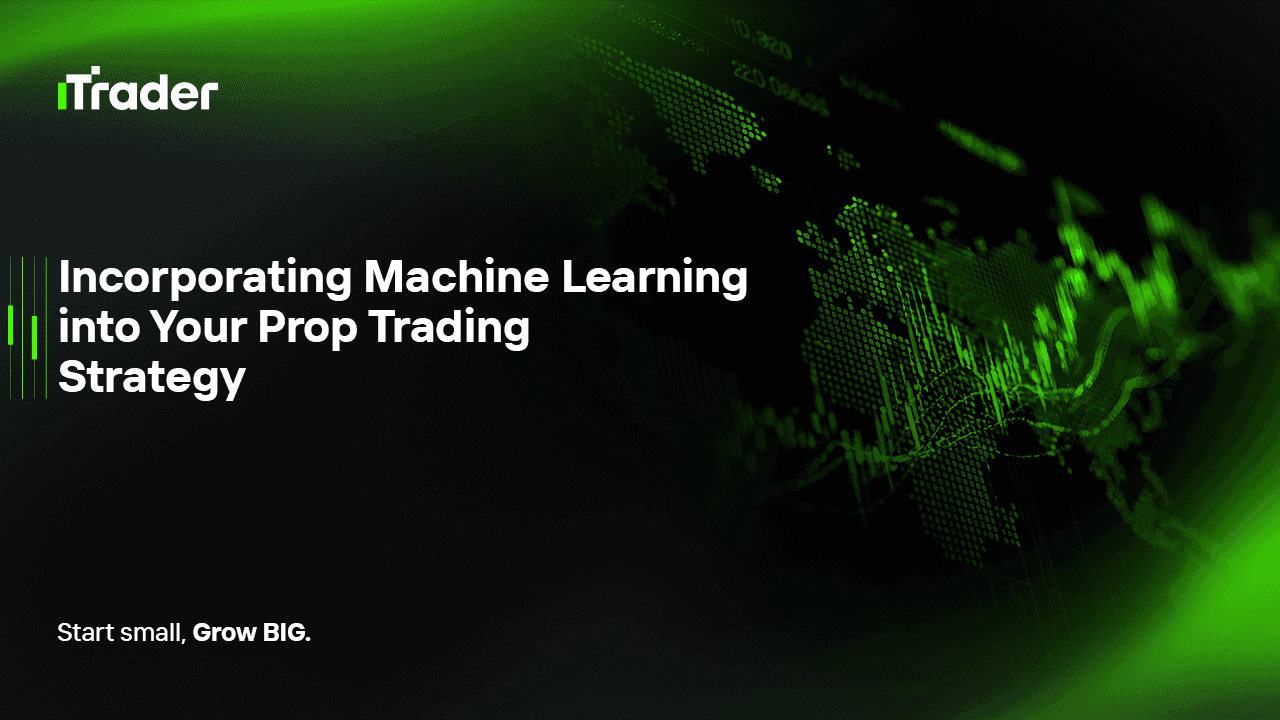2025-07-25
In forex market, the most successful traders are not those relying solely on intuition, but those who make decisions rooted in data, probability, and systems thinking. With the rapid evolution of financial technology, machine learning (ML) and artificial intelligence (AI) are becoming essential tools that help traders minimize cognitive errors, discover market patterns, and automate decision-making with precision. For proprietary traders—where performance consistency is vital—ML/AI offers a competitive edge by turning raw data into actionable signals.

AI Summary:
This blog explores how machine learning (ML) and artificial intelligence (AI) can be integrated into forex trading strategies, specifically tailored for proprietary traders. It walks through the strategic benefits of using data-driven models, practical applications such as regime detection and signal generation, and outlines a structured roadmap to deploy ML/AI in trading systems. The goal is to help traders increase adaptability, reduce emotional bias, and build robust systems that adjust with market conditions.
Artificial Intelligence (AI) refers to systems that mimic human decision-making and reasoning, while Machine Learning (ML) is a subfield of AI focused on algorithms that learn from data patterns and improve over time without being explicitly programmed. In trading, AI supports automation and adaptation, whereas ML is used to forecast prices, detect regimes, and generate signals based on learned patterns.
1. Pattern Detection Beyond Human Intuition
ML models can identify complex, nonlinear relationships that are often invisible to traditional indicators. These patterns are often scale-invariant and dynamic—ideal for high-volatility environments.
2. Real-Time Adaptation
As market conditions shift, ML models can retrain on new data and respond faster than rule-based systems, which often require manual reconfiguration.
3. Systematic Decision-Making
Machine learning helps eliminate emotional bias, enabling objective, repeatable strategies. It’s particularly effective when testing thousands of scenarios across multiple timeframes or instruments.
A. Direction Prediction
Supervised learning models such as logistic regression, random forests, and XGBoost can classify market direction based on features like moving average crossovers, RSI levels, and macro indicators. The output helps decide whether to go long, short, or stay neutral.
B. Signal Generation
Time-series forecasting techniques, including ARIMA, Prophet, and LSTM (a deep learning model), can be used to predict price movements and generate trading signals. When the model forecasts significant directional movement, it triggers trade entries or exits.
C. Regime Detection and Strategy Switching
Unsupervised learning methods help detect structural changes in the market—such as volatility spikes or trend exhaustion. Techniques like PCA and K-means clustering group similar market environments, allowing you to apply different strategies per regime.
D. Sentiment Analysis Using NLP
Natural Language Processing (NLP) allows you to extract market sentiment from social media, news feeds, or financial reports. Models like BERT or RoBERTa can analyze tone and context to forecast risk-on or risk-off behavior in the market.
1. Data Collection and Preparation
Start by gathering high-quality price data, macroeconomic indicators, and possibly text-based data. Clean and normalize the data to remove noise, fill gaps, and standardize formats.
2. Model Selection and Training
Choose an appropriate ML technique depending on your goal: supervised for prediction, unsupervised for clustering, or reinforcement learning for decision-making under uncertainty. Use cross-validation and regularization techniques to avoid overfitting.
3. Backtesting and Forward Testing
Apply your model to historical data using realistic trading conditions, including slippage, spreads, and execution delays. Use walk-forward analysis to simulate how your model performs in changing market environments.
4. Deployment into Live Trading
Integrate your model with platforms like MetaTrader via Python APIs or connect it to your broker’s execution system. Ensure the strategy includes real-time monitoring and alert systems to track performance and intervene if needed.
Advantages:
Challenges:
Proprietary firms are actively integrating ML/AI across several key areas:
While some firms hire quantitative researchers and data scientists to build complex models, others empower traders to construct semi-automated strategies using open-source tools and cloud-based infrastructure.
Explainable AI (XAI):
New frameworks are emerging to help traders understand why an AI model made a certain decision, improving trust and transparency.
Reinforcement Learning:
AI agents learn by receiving rewards or penalties for trading outcomes, making them ideal for complex environments like order flow prediction or multi-asset allocation.
Multi-Agent Systems:
Simulating market environments using multiple AI agents that compete or cooperate to discover emergent trading strategies.
Synthetic Data Generation:
Generative models like GANs are being used to create artificial price series for robust testing across unseen scenarios.
Machine learning and artificial intelligence are not magic bullets, but they can vastly improve the precision, consistency, and adaptability of your trading systems. For prop traders, where performance is everything, AI can help filter noise, reveal edge, and automate complex decisions. However, successful adoption requires a deep understanding of both markets and machine learning principles. Those who combine domain expertise with data science will be at the forefront of next-generation trading.
© 2025 iTrader Global Limited | หมายเลขทะเบียนบริษัท: 15962
iTrader Global Limited ตั้งอยู่ที่ Hamchako, Mutsamudu, เกาะปกครองตนเอง Anjouan, สหภาพคอโมโรส และได้รับใบอนุญาตและอยู่ภายใต้การกำกับดูแลของคณะกรรมการหลักทรัพย์แห่งคอโมโรส ภายใต้หมายเลขใบอนุญาต L15962/ITGL
iTrader Global Limited ดำเนินการภายใต้ชื่อทางการค้า “iTrader” และได้รับอนุญาตให้ดำเนินกิจกรรมการซื้อขายฟอเร็กซ์ โลโก้ เครื่องหมายการค้า และเว็บไซต์ของบริษัทเป็นทรัพย์สินเฉพาะของ iTrader Global Limited
บริษัทย่อยอื่น ๆ ของ iTrader Global Limited ได้แก่ iTrader Global Pty Ltd หมายเลขทะเบียนบริษัทออสเตรเลีย (ACN): 686 857 198 โดยบริษัทนี้เป็นตัวแทนที่ได้รับอนุญาต (หมายเลขตัวแทนบริการทางการเงินของออสเตรเลีย (AFS): 001315037) ของ Opheleo Holdings Pty Ltd (ใบอนุญาตบริการทางการเงินของออสเตรเลีย (AFSL): 000224485) ซึ่งมีที่อยู่จดทะเบียนอยู่ที่ Level 1, 256 Rundle St, Adelaide, SA 5000 ข้อจำกัดความรับผิดชอบ: นิติบุคคลนี้ไม่ใช่ผู้ออก และไม่รับผิดชอบต่อผลิตภัณฑ์ทางการเงินที่ซื้อขายบนหรือผ่านเว็บไซต์นี้
คำเตือนความเสี่ยง: การซื้อขาย CFD มีความเสี่ยงสูงต่อการสูญเสียเงินทุนอย่างรวดเร็วเนื่องจากเลเวอเรจ และอาจไม่เหมาะสมกับผู้ใช้ทุกคน
การซื้อขายกองทุน CFD และผลิตภัณฑ์ที่มีเลเวอเรจสูงอื่น ๆ ต้องการความรู้เฉพาะทาง
จากผลการวิจัยพบว่า 84.01% ของผู้เทรดที่ใช้เลเวอเรจประสบกับการขาดทุน
โปรดตรวจสอบให้แน่ใจว่าคุณเข้าใจความเสี่ยงทั้งหมด และพร้อมที่จะสูญเสียเงินทุนก่อนที่คุณจะเข้าร่วมการซื้อขายที่มีเลเวอเรจ
iTrader ขอประกาศว่า บริษัทจะไม่รับผิดชอบต่อความเสี่ยง ความเสียหาย หรือการสูญเสียใด ๆ ที่เกิดขึ้นจากการซื้อขายแบบมีเลเวอเรจต่อบุคคลหรือนิติบุคคลใด ๆ ทั้งสิ้น
ข่าวสารและข้อมูลที่ปรากฏบนเว็บไซต์นี้มีไว้เพื่อวัตถุประสงค์ทางการศึกษาเท่านั้น ผู้ใช้ควรตัดสินใจทางการเงินอย่างอิสระและโดยใช้ข้อมูลอย่างรอบคอบ
ข้อจำกัด: iTrader ไม่ได้มุ่งเป้าเว็บไซต์หรือบริการไปยังผู้อยู่อาศัยในประเทศที่กฎหมายหรือข้อบังคับห้ามไม่ให้มีการทำธุรกรรมดังกล่าว
หากคุณอาศัยอยู่ในเขตอำนาจที่การใช้เว็บไซต์หรือบริการนี้ถูกจำกัด คุณต้องรับผิดชอบในการปฏิบัติตามกฎหมายท้องถิ่น
iTrader ไม่รับประกันว่าเนื้อหาบนเว็บไซต์ของบริษัทจะเหมาะสมหรือถูกต้องตามกฎหมายในทุกพื้นที่